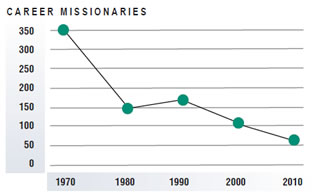by Kim Plummer Krull

In 1971, a peak high of more than 350 LCMS missionary families dedicated their lives to serving the Lord in foreign fields. Today, 59 such career missionary families (which often include both a husband and wife with calls to serve) work in other countries. But instead of focusing on decline, Dr. Dave Birner (DB), associate executive director, international, for LCMS World Mission, explains to The Lutheran Witness staff (LW) that those numbers say more about dramatic changes in our world and how our church bears witness in the 21st century.
LW: Briefly explain why the Synod’s historic practice of sending career missionaries into the field has changed.
DB: In 1895, the Synod began mission work in India, our first foreign mission field. The LCMS sent its first international missionary 50 years after the Synod was established. That’s worth noting because many of our partner churches are just now reaching that 50-year mark themselves. It’s around that time when a church body, with the benefit of two to three generations of believers, has the ability to sustain its own missionary force, which is what we’re seeing today with many partner churches whose roots are in LCMS mission work.

LW: Why the decline in the number of career missionaries over the past 40 years?
DB: A variety of issues have contributed to the decline, including geopolitical, economic and cultural factors. The logistics of overseas travel (including visa requirements) and unpredictable world politics have made it more difficult. The social upheavals of the 1960s and 1970s and the changing role of the United States abroad made people more reluctant to venture into a hostile world. Reflecting the changing American lifestyle and economic standards, baby boomers coming of age in the 1970s and 1980s were accustomed to different needs and challenges than their parents and grandparents who came out of the Depression and World War II.
Changes within our Synod also impacted mission work. Internal conflicts in the 1970s dramatically disrupted the mission board and missionary recruitment. During the same period, the Synod made the decision to grant partner-church status to a number of church bodies that began as a result of missionary work. Those partners often replaced the work of missionaries with workers from their own countries.
Just as the Saxons who founded our Synod started a school before they started a church, the LCMS helps our partners put into place ministries to sustain a believing community with schools, seminaries, clinics and other human-care work.
We’ve also seen dramatic increases in costs to support a missionary family overseas—at least $500,000 to support one missionary family for the first five years of missionary service. We have expenses we didn’t have in the 1960s and 1970s (health care, insurance, retirement, children’s education, etc.), and at the same time, people are giving less to the church.
LW: In spite of changes and challenges, you sound enthusiastic about the future of LCMS mission work. Why?
DB: There are exciting opportunities! We’ve seen a dramatic increase in the number of short-term missionaries who supplement the work of long-term, career missionaries. The world is more accessible today to our congregations, and they are responding. They have a mission passion and want to go serve. But at the same time, we also need more career missionaries. They are the ones who invest years to learn language and customs and become close friends with our partners. Eventually, those partners build their own missionary force.
Today, our partner churches are working shoulder to shoulder with LCMS missionaries around the world. In some countries, our partner-church missionaries have discovered a natural affinity for work among a particular people.
So as we join with our brothers and sisters who share our Lutheran roots and church family tree, we are discovering that a brand new global missionary force is emerging to meet the needs of the 21st century world.
God used LCMS missionaries to plant new church bodies in the last century, and I believe by doing so that He prepared us. Now He is placing us within a global body of believers for mission. And He will use us powerfully within this expanded multinational missionary force to plant even more sustainable communities of believers in the many parts of the world that long for hope and Good News.
—
> What can I do to help contribute to Witness? Go to www.lcms.org/projects
> To learn more about mission work, go to www.lcms.org/missionaries
Quick Facts
As of March 2011, the LCMS supports 59 international career missionary families, filling 69 paid positions (some husband-wife cases).
- 33 clergy
- 1 deaconess
- 4 DCE/DCO
- 8 teachers
- 2 medical missionaries
- 21 laypersons
The team also includes:
- 53 international educators serving in 6 countries in Asia
- 80 GEO (globally engaged in outreach) missionaries serving 1–2 years
- 476 individuals served on short-term teams throughout 2010
- 72 individuals served or are serving in short-term opportunities during 2010–2011
—
About the Author: Kim Plummer Krull is a member of St. Paul’s Lutheran Church, Des Peres, Mo.
May 2011


